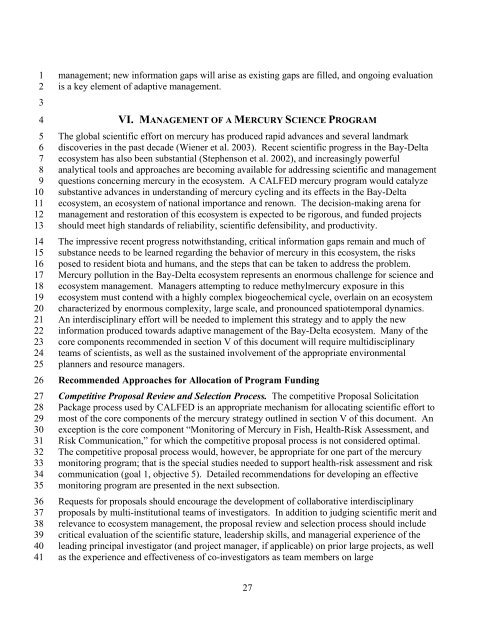Mercury Strategy for the Bay-Delta Ecosystem - CALFED Bay-Delta ...
Mercury Strategy for the Bay-Delta Ecosystem - CALFED Bay-Delta ...
Mercury Strategy for the Bay-Delta Ecosystem - CALFED Bay-Delta ...
You also want an ePaper? Increase the reach of your titles
YUMPU automatically turns print PDFs into web optimized ePapers that Google loves.
1<br />
2<br />
3<br />
4<br />
5<br />
6<br />
7<br />
8<br />
9<br />
10<br />
11<br />
12<br />
13<br />
14<br />
15<br />
16<br />
17<br />
18<br />
19<br />
20<br />
21<br />
22<br />
23<br />
24<br />
25<br />
26<br />
27<br />
28<br />
29<br />
30<br />
31<br />
32<br />
33<br />
34<br />
35<br />
36<br />
37<br />
38<br />
39<br />
40<br />
41<br />
management; new in<strong>for</strong>mation gaps will arise as existing gaps are filled, and ongoing evaluation<br />
is a key element of adaptive management.<br />
VI. MANAGEMENT OF A MERCURY SCIENCE PROGRAM<br />
The global scientific ef<strong>for</strong>t on mercury has produced rapid advances and several landmark<br />
discoveries in <strong>the</strong> past decade (Wiener et al. 2003). Recent scientific progress in <strong>the</strong> <strong>Bay</strong>-<strong>Delta</strong><br />
ecosystem has also been substantial (Stephenson et al. 2002), and increasingly powerful<br />
analytical tools and approaches are becoming available <strong>for</strong> addressing scientific and management<br />
questions concerning mercury in <strong>the</strong> ecosystem. A <strong>CALFED</strong> mercury program would catalyze<br />
substantive advances in understanding of mercury cycling and its effects in <strong>the</strong> <strong>Bay</strong>-<strong>Delta</strong><br />
ecosystem, an ecosystem of national importance and renown. The decision-making arena <strong>for</strong><br />
management and restoration of this ecosystem is expected to be rigorous, and funded projects<br />
should meet high standards of reliability, scientific defensibility, and productivity.<br />
The impressive recent progress notwithstanding, critical in<strong>for</strong>mation gaps remain and much of<br />
substance needs to be learned regarding <strong>the</strong> behavior of mercury in this ecosystem, <strong>the</strong> risks<br />
posed to resident biota and humans, and <strong>the</strong> steps that can be taken to address <strong>the</strong> problem.<br />
<strong>Mercury</strong> pollution in <strong>the</strong> <strong>Bay</strong>-<strong>Delta</strong> ecosystem represents an enormous challenge <strong>for</strong> science and<br />
ecosystem management. Managers attempting to reduce methylmercury exposure in this<br />
ecosystem must contend with a highly complex biogeochemical cycle, overlain on an ecosystem<br />
characterized by enormous complexity, large scale, and pronounced spatiotemporal dynamics.<br />
An interdisciplinary ef<strong>for</strong>t will be needed to implement this strategy and to apply <strong>the</strong> new<br />
in<strong>for</strong>mation produced towards adaptive management of <strong>the</strong> <strong>Bay</strong>-<strong>Delta</strong> ecosystem. Many of <strong>the</strong><br />
core components recommended in section V of this document will require multidisciplinary<br />
teams of scientists, as well as <strong>the</strong> sustained involvement of <strong>the</strong> appropriate environmental<br />
planners and resource managers.<br />
Recommended Approaches <strong>for</strong> Allocation of Program Funding<br />
Competitive Proposal Review and Selection Process. The competitive Proposal Solicitation<br />
Package process used by <strong>CALFED</strong> is an appropriate mechanism <strong>for</strong> allocating scientific ef<strong>for</strong>t to<br />
most of <strong>the</strong> core components of <strong>the</strong> mercury strategy outlined in section V of this document. An<br />
exception is <strong>the</strong> core component “Monitoring of <strong>Mercury</strong> in Fish, Health-Risk Assessment, and<br />
Risk Communication,” <strong>for</strong> which <strong>the</strong> competitive proposal process is not considered optimal.<br />
The competitive proposal process would, however, be appropriate <strong>for</strong> one part of <strong>the</strong> mercury<br />
monitoring program; that is <strong>the</strong> special studies needed to support health-risk assessment and risk<br />
communication (goal 1, objective 5). Detailed recommendations <strong>for</strong> developing an effective<br />
monitoring program are presented in <strong>the</strong> next subsection.<br />
Requests <strong>for</strong> proposals should encourage <strong>the</strong> development of collaborative interdisciplinary<br />
proposals by multi-institutional teams of investigators. In addition to judging scientific merit and<br />
relevance to ecosystem management, <strong>the</strong> proposal review and selection process should include<br />
critical evaluation of <strong>the</strong> scientific stature, leadership skills, and managerial experience of <strong>the</strong><br />
leading principal investigator (and project manager, if applicable) on prior large projects, as well<br />
as <strong>the</strong> experience and effectiveness of co-investigators as team members on large<br />
27

















